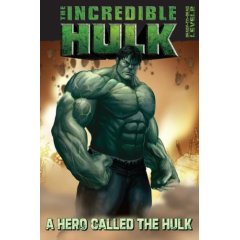PG-13 Superheroes in Pre-K Books
Posted on July 22, 2008 at 5:31 pm
Children’s book author Erica S. Perl has a gallery in Slate about books for early readers featuring superheroes from PG-13 movies like The Incredible Hulk and Iron Man and even the very violent and disturbing Dark Knight. Perl reports that
at many chain bookstores there is now a specifically labeled “At the Movies” tier on the early-reader rack. This isn’t the first time brand extensions have shown up in early readers–books starring SpongeBob and Dora the Explorer have been around for several years now. But there’s something more unsettling about books aimed at preschoolers and kindergartners featuring PG-13 movie characters, and they pose a tricky question for parents. Books like A Hero Called the Hulk and The Dark Knight: I Am Batman practically beg to be plucked by small hands.
Perl says that some of these books are educationally sound, while others are not.
I Am Iron Man!, one of the best of the bunch, blithely ignores much of the plot of the movie my husband called “the loudest film ever made,” and Guido Guidi’s drawings of Iron Man’s suit convey the undeniable excitement of a snazzy magic flying costume. As important, his pictures provide a good jumping-off point for kids who want to make up their own stories about gaining the power to soar through the skies. Other movie-based early readers, however, present problems. A Hero Called the Hulk, seen here, provides none of the educational scaffolding beginning readers need.
Pedagogical value aside, I think it is wrong to use these books to market characters and movies to kids who are too young for them. Earlier this year, the Federal Trade Commission urged the Motion Picture Association of America to reconsider guidelines that allow some PG-13 movies to be marketed to young children, following a complaint by an advocacy group that the blockbuster film “Transformers” was inappropriately advertised to children as young as 2. It also urged toy manufacturers, fast-food chains and retailers to review how they sell movie-based toys to young children. These books are essentially ads for movies that are inappropriate for children and the Federal Trade Commission and the MPAA should prohibit this kind of licensing for products intended for those who are too young to see the movie.
FTC contact: Mary Engle, Director of the Division of Advertising Practices
* Online:secure complaint form
* Phone: Toll-free helpline: 1-877-FTC-HELP (1-877-382-4357);
TTY: 1-866-653-4261
* Mail:
Federal Trade Commission
Consumer Response Center
600 Pennsylvania Avenue, NW
Washington, DC 20580
Or complain to the publisher:
Carolyn Kroll Reidy
CEO, Simon & Schuster, Inc.
1230 Avenue of the Americas
New York, NY 10020
Phone: 212-698-7000



